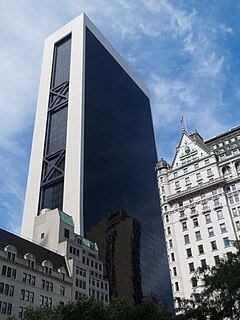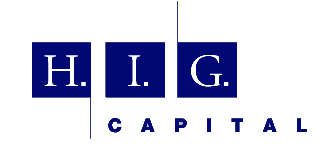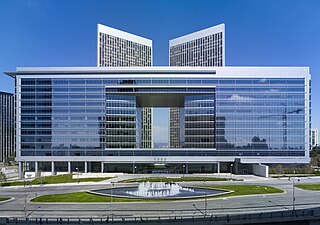Related Research Articles

In finance, a high-yield bond is a bond that is rated below investment grade by credit rating agencies. These bonds have a higher risk of default or other adverse credit events, but offer higher yields than investment-grade bonds in order to compensate for the increased risk.

A leveraged buyout (LBO) is one company's acquisition of another company using a significant amount of borrowed money (leverage) to meet the cost of acquisition. The assets of the company being acquired are often used as collateral for the loans, along with the assets of the acquiring company. The use of debt, which normally has a lower cost of capital than equity, serves to reduce the overall cost of financing the acquisition. The cost of debt is lower because interest payments often reduce corporate income tax liability, whereas dividend payments normally do not. This reduced cost of financing allows greater gains to accrue to the equity, and, as a result, the debt serves as a lever to increase the returns to the equity.
Private equity (PE) typically refers to investment funds, generally organized as limited partnerships, that buy and restructure companies. More formally, private equity is a type of equity and one of the asset classes consisting of equity securities and debt in operating companies that are not publicly traded on a stock exchange.

KKR & Co. Inc. is an American global investment company that manages multiple alternative asset classes, including private equity, energy, infrastructure, real estate, credit, and, through its strategic partners, hedge funds. The firm has completed more than 280 private equity investments in portfolio companies with approximately $545 billion of total enterprise value as of June 30, 2017. As of September 30, 2017, Assets Under Management ("AUM") and Fee Paying Assets Under Management ("FPAUM") were $153 billion and $114 billion, respectively.
GE Capital is the financial services division of General Electric. Through its two divisions, GE Capital Aviation Services and GE Energy Financial Services.

A syndicated loan is one that is provided by a group of lenders and is structured, arranged, and administered by one or several commercial banks or investment banks known as lead arrangers.

Apollo Global Management, Inc. is a global alternative investment management firm. It invests in credit, private equity, and real assets. As of December 31, 2020, the company had $455.5 billion of assets under management, including $328.6 billion invested in credit, including mezzanine capital, hedge funds, non-performing loans and collateralized loan obligations, $80.7 billion invested in private equity, and $46.2 billion invested in real assets, which includes real estate and infrastructure. The company invests money on behalf of pension funds, financial endowments and sovereign wealth funds, as well as other institutional and individual investors. Since inception in 1990, private equity funds managed by Apollo have produced a 24% internal rate of return (IRR) to investors, net of fees.
Cov-lite is financial jargon for loan agreements that do not contain the usual protective covenants for the benefit of the lending party. Although traditionally banks have insisted on a wide range of covenants that allow them to intervene if the financial position of the borrower or the value of underlying assets deteriorates, around 2006 the increasing strength of private equity firms and the decreasing opportunities for traditional corporate loans made by banks fueled something of a "race to the bottom", with syndicates of banks competing with each other to offer ever less invasive terms to borrowers in relation to leveraged buy-outs.

Collateralized loan obligations (CLOs) are a form of securitization where payments from multiple middle sized and large business loans are pooled together and passed on to different classes of owners in various tranches. A CLO is a type of collateralized debt obligation.
Angelo Gordon is a global alternative investment manager founded in November 1988 by John M. Angelo and Michael L. Gordon who together ran the arbitrage department of L.F. Rothschild in the 1980s.

H.I.G. Capital is a Miami, Florida–based private equity and alternative assets investment firm with $45 billion of equity capital under management. The firm operates a family of private equity, growth equity, credit/special situation, primary lending, syndicated credit, and real estate funds. The company provides both debt and equity capital to small and mid-sized companies.

Private equity in the 2000s represents one of the major growth periods in the history of private equity and venture capital. Within the broader private equity industry, two distinct sub-industries, leveraged buyouts and venture capital expanded along parallel and interrelated tracks.

Ares Management Corporation is an American global alternative investment manager operating in the credit, private equity and real estate markets. The company was founded in 1997 and is headquartered in Los Angeles, California, with additional offices across North America, Europe, and Asia.

GSO Capital Partners is an American privately owned hedge fund and the credit investment arm of The Blackstone Group. GSO is one of the largest credit-oriented alternative asset managers in the world and a major participant in the leveraged finance marketplace. The firm invests across a variety of credit oriented strategies and products including collateralized loan obligation vehicles investing in secured loans, hedge funds focused on special situations investments, mezzanine debt funds and private equity funds focused on rescue financing.
On March 23, 2009, the United States Federal Deposit Insurance Corporation (FDIC), the Federal Reserve, and the United States Treasury Department announced the Public–Private Investment Program for Legacy Assets. The program is designed to provide liquidity for so-called "toxic assets" on the balance sheets of financial institutions. This program is one of the initiatives coming out of the implementation of the Troubled Asset Relief Program (TARP) as implemented by the U.S. Treasury under Secretary Timothy Geithner. The major stock market indexes in the United States rallied on the day of the announcement rising by over six percent with the shares of bank stocks leading the way. As of early June 2009, the program had not been implemented yet and was considered delayed. Yet, the Legacy Securities Program implemented by the Federal Reserve has begun by fall 2009 and the Legacy Loans Program is being tested by the FDIC. The proposed size of the program has been drastically reduced relative to its proposed size when it was rolled out.

Centerbridge Partners is a multi-strategy private investment firm focused on leveraged buyouts and distressed securities.
Kabbage, Inc. is an online financial technology company based in Atlanta, Georgia. The company provides funding directly to small businesses and consumers through an automated lending platform.
SoFi Technologies, Inc. is an American online personal finance company. Based in San Francisco, SoFi provides financial products that includes student loan refinancing, mortgages, personal loans, credit card, investing, and banking through both mobile app and desktop interfaces.
Golub Capital is a credit asset manager based in the United States with over $40 billion of capital under management. The firm has primary business lines in middle market lending, late stage lending, and broadly syndicated loans. The firm is also affiliated with Golub Capital BDC, Inc., a business development company that trades on the NASDAQ under the stock ticker symbol, GBDC. Golub Capital is one of the largest non-bank middle market lenders and providers of senior debt.
The corporate debt bubble is the large increase in corporate bonds, excluding that of financial institutions, following the financial crisis of 2007–08. Global corporate debt rose from 84% of gross world product in 2009 to 92% in 2019, or about $72 trillion. In the world's eight largest economies—the United States, China, Japan, the United Kingdom, France, Spain, Italy, and Germany—total corporate debt was about $51 trillion in 2019, compared to $34 trillion in 2009. Excluding debt held by financial institutions—which trade debt as mortgages, student loans, and other instruments—the debt owed by non-financial companies in early March 2020 was $13 trillion worldwide, of which about $9.6 trillion was in the U.S.
References
- ↑ "Unitranche Lending Basics | Law Bulletins | Taft Stettinius & Hollister LLP". www.taftlaw.com. Retrieved 2021-09-11.
- ↑ "Leveraged Finance Structure Series: Unitranche Versus Syndicated Loans (Unitranche Borrowers Eye Simple Execution Despite Variety of Risks)". www.fitchratings.com. Retrieved 2021-09-11.
- ↑ Gilligan, John; Wright, Mike (2020-11-04). Private Equity Demystified: An Explanatory Guide. Oxford University Press. p. 183. ISBN 978-0-19-263680-5.
- ↑ "Unitranche Financing – is it for you?". The National Law Review. Retrieved 2021-09-15.
- ↑ "Distressed Unitranche Debt After RadioShack: While Instructive, No Cause For Comfort". ABFJournal. Retrieved 2021-09-15.
- ↑ Ippolito, Roberto (2020-02-03). Private Capital Investing: The Handbook of Private Debt and Private Equity. John Wiley & Sons. p. 44. ISBN 978-1-119-52616-2.
- ↑ Nijs, Luc (2013-10-15). Mezzanine Financing: Tools, Applications and Total Performance. John Wiley & Sons. ISBN 978-1-118-76520-3.
- ↑ Hedlund, Andrew (2020-02-19). "Rise in private credit leads to boost in unitranche loans". Reuters. Retrieved 2021-09-11.
- ↑ Davis, Ben. "The Evolution of Unitranche". Reed Smith.
- ↑ Sierra, Michelle (2019-12-23). "Leveraged loan market size doubles in ten years, private credit explodes". Reuters. Retrieved 2021-09-11.
- ↑ "Private Equity Firms Are Cutting Out Banks and Funding LBOs Themselves". Bloomberg.com. 2021-08-11. Retrieved 2021-09-11.
- ↑ "Why Unitranche Loans Grew From Niche to Billions". Bloomberg.com. 2021-08-07. Retrieved 2021-09-11.
- ↑ "2021 Outlook: Direct lending to make its mark in European mid-market". www.spglobal.com. Retrieved 2021-09-15.
- ↑ Writer, Guest (2021-02-01). "Why unitranche may struggle to replace bank loans in Europe". Private Debt Investor. Retrieved 2021-09-15.
- ↑ Brooke, David (2018-10-09). "'Unitranche killer' hits Europe's middle market". Reuters. Retrieved 2021-09-15.